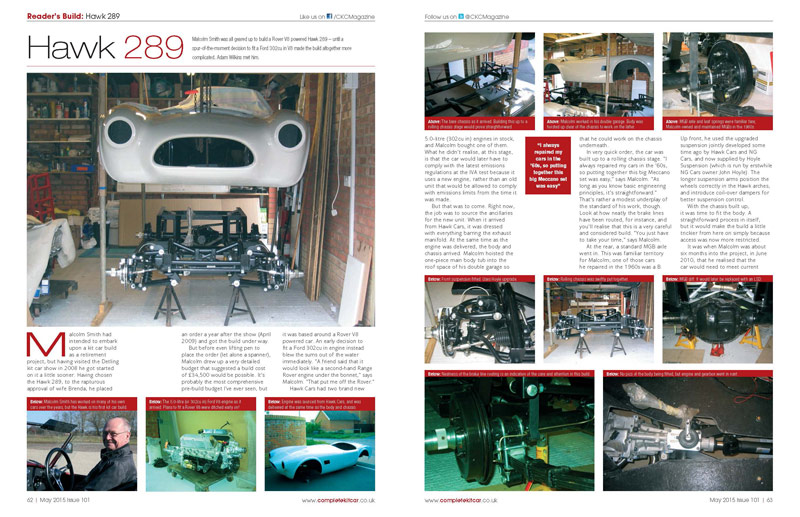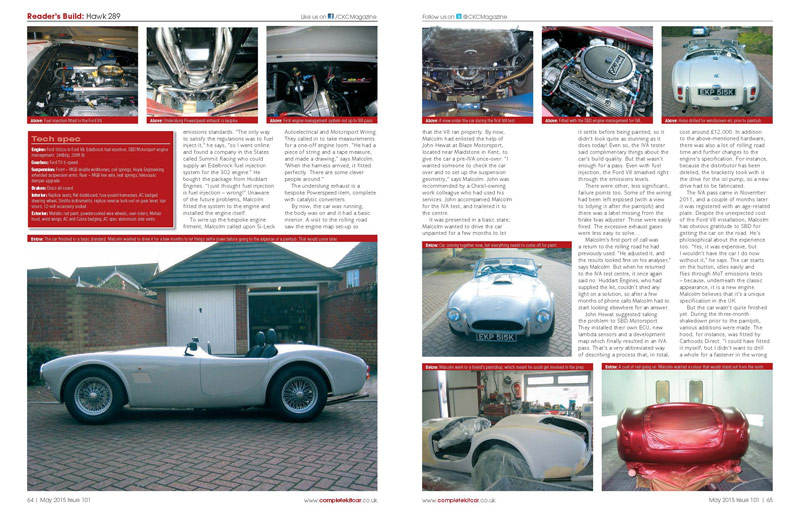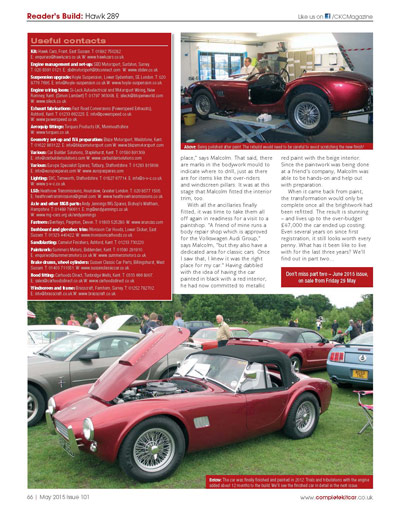Complete Kit Car, May 2015
Malcolm Smith was all geared up to build a Rover V8 powered Hawk 289 — until a spur-of-the-moment decision to fit a Ford 302cu in V8 made the build altogether more complicated. Adam Wilkins met him.
Malcolm Smith had intended to embark upon a kit car build as a retirement project, but having visited the Detling kit car show in 2008 he got started on it a little sooner. Having chosen the Hawk 289, to the rapturous approval of wife Brenda, he placed an order a year after the show (April 2009) and got the build under way.
But before even lifting pen to place the order (let alone a spanner), Malcolm drew up a very detailed budget that suggested a build cost of £34,500 would be possible. It’s probably the most comprehensive pre-build budget I’ve ever seen, but it was based around a Rover V8 powered car. An early decision to fit a Ford 302cu in engine instead blew the sums out of the water immediately. “A friend said that it would look like a second-hand Range Rover engine under the bonnet,” says Malcolm. “That put me off the Rover.”

Hawk Cars had two brand new 5.0-litre (302cu) engines in stock and Malcolm bought one of them. What he didn’t realise, at this stage, is that the car would later have to comply with the latest emissions regulations at the IVA test because it uses a new engine, rather than an old unit that would be allowed to comply with emissions limits from the time it was made.
But that was to come. Right now, the job was to source the ancillaries for the new unit. When it arrived from Hawk Cars, it was dressed with everything barring the exhaust manifold. At the same time as the engine was delivered, the body and chassis arrived. Malcolm hoisted the one-piece main body tub into the roof space of his double garage so that he could work on the chassis underneath.
In very quick order, the car was built up to a rolling chassis stage. “I always repaired my cars in the ‘60s, so putting together this big Meccano set was easy,” says Malcolm. “As long as you know basic engineering principles, it’s straightforward.” That’s rather a modest underplay of the standard of his work, though. Look at how neatly the brake lines have been routed, for instance, and you’ll realise that this is a very careful and considered build. “You just have to take your time,” say Malcolm.
At the rear, a standard MGB axle went in. This was familiar territory for Malcolm; one of those cars he repaired in the 1960s was a B. Up front, he used the upgraded suspension jointly developed some time ago by Hawk Cars and NG Cars, and now supplied by Hoyle Suspension (which is run by erstwhile NG Cars owner John Hoyle). The longer suspension arms position the wheels correctly in the Hawk arches, and introduce coil-over dampers for better suspension control.
With the chassis built up, it was time to fit the body. A straightforward process in itself, but it would make the build a little trickier from here on simply because access was now more restricted.
It was when Malcolm was about six months into the project, in June 2010, that he realised that the car would need to meet current emissions standards. “The only way to satisfy the regulations was to fuel inject it,” he says, “so I went online and found a company in the States called Summit Racing who could supply an Edelbrock fuel injection system for the 302 engine.” He bought the package from Huddart Engine. “I just thought fuel injection is fuel injection — wrong!” Unaware of the future problems, Malcolm fitted the system to the engine and installed the engine itself.
To wire up the bespoke engine fitment, Malcolm called upon Si-Leck Autoelectrical and Motorsport Wiring. They called in to take measurements for a one-off engine loom. “He had a piece of string and tape measure, and made a drawing,” says Malcom. “When the harness arrived, it fitted perfectly. There are some clever people around.”
The underslung exhaust is a bespoke Powerspeed item, complete with catalytic converters.

By now, the car was running, the body was on and it had a basic interior. A visit to the rolling road saw the engine map set-up so that the V8 ran properly. By now, Malcolm had enlisted the help of John Hewat at Blaze Motorsport located near Maidstone in Kent, to give the car a pre-IVA once-over. “I wanted someone to check the car over and to set up the suspension geometry,” say Malcolm. John was recommended by a Chesil-owning work colleague who had used his services. John accompanied Malcolm for the IVA test, and trailered it to the centre.
It was presented in a basic state, Malcolm wanted to drive the car unpainted for a few months to let it settle before being painted, so it didn’t look quite so stunning as it does today! Even so, the IVA tester said complimentary things about the car’s build quality. But that wasn’t enough for a pass. Even with fuel injection, the Ford V8 smashed right through the emission levels.
There were other, less significant failure points too. Some of the wiring had been left exposed (with a view to tidying it after the paintjob) and there was a label missing from the braked bias adjuster. Those were easily fixed. The excessive exhaust gases were less easy to solve….
Malcolm’s first port of call was a return to the rolling road he had previously used. “He adjusted it, and the results looked fine on his analyser,” says Malcolm. But when he returned to the IVA test centre, it once again said no. Huddart Engines, who had supplied the kit, couldn’t shed any light on a solution, so after a few months of phone calls Malcolm had to start looking elsewhere for an answer.
John Hewat suggested taking the problem to SBD Motorsport. They installed their own ECU, new lambda sensors and a development map which finally resulted in an IVA pass. That’s a very abbreviated way of describing a process that, in total, cost around £12,000. In addition to the above-mentioned hardware, there was also a lot of rolling road time and further changes to the engine’s specification. For instance, because distributor had been deleted, the bracketry took with it the drive for the oil pump, so a new drive had to be fabricated.
The IVA pass came in November 2011, and a couple of months later it was registered with an age-related plate. Despite the unexpected cost of the Ford V8 installation, Malcolm has obvious gratitude to SBD for getting the car on the road. He’s philosophical about the experience too. “Yes, it was expensive, but I wouldn’t have the car I do now without,” he says. The car starts on the button, idles easily and flies through MoT emissions tests — underneath the classic appearance, it is a new engine. Malcolm believes that it’s a unique specification in the UK.
But the car wasn’t quite finished yet. During the three-month shakedown prior to the paint-job, various additions were made. The hood, for instance, was fitted by Carhoods Direct. “I could have fitted it myself, but I didn’t want to drill a hole for a fastener in the wrong place,” says Malcolm. That said, there are marks in the bodywork mould to indicate where to drill, just as there are for items like the over-riders and windscreen pillars. It was at this stage that Malcolm fitted the interior trim too.
With all the ancillaries finally fitted, it was time to take them all off again in readiness for a visit to a paintshop. “A friend of mine runs a body repair shop which is approved for the Volkswagen Audi Group,” says Malcolm, “but they also have a dedicated area for classic cars. Once I saw that, I knew it would be the right place for my car.” Having dabbled with the idea of having the car painted in black with a red interior, he had now committed to metallic red paint with the beige interior. Since the paintwork was being done at a friend’s company, Malcolm was able to be hands-on and help out with preparation.
When it came back from paint, the transformation would only be complete once all the brightwork had been re-fitted. The result is stunning — and lives up to the over-budget £47,000 the car ended up costing. Even several years on since first registration, it still looks worth every penny. What has it been like to live with for the last three years? We’ll find out in part two…..

Tech Spec
Engine: Ford 302cu in Ford V8, Edelbrock fuel injection, SBD Motorsport engine management, 246bhp, 256ft.lb
Gearbox: Ford T5 5-speed
Suspension: Front — MGB double wishbones, coil springs, Hoyle Engineering extended suspension arms. Rear — MGB live axle, leaf springs, telescopic damper upgrade
Brakes: Discs all-round
Interior: Replica seats, flat dashboard, four-point harnesses, AC badged steering wheel, Smiths instruments, replica reverse lock-out on gear lever, sun visors, 12-volts accessary socket
Exterior: Metallic red paint, powdercoated wire wheels, over-riders, Mohair hood, wind wings, AC and Cobra badging, AC spec aluminium side vents
Reproduced by permission of Complete Kit Car Magazine
